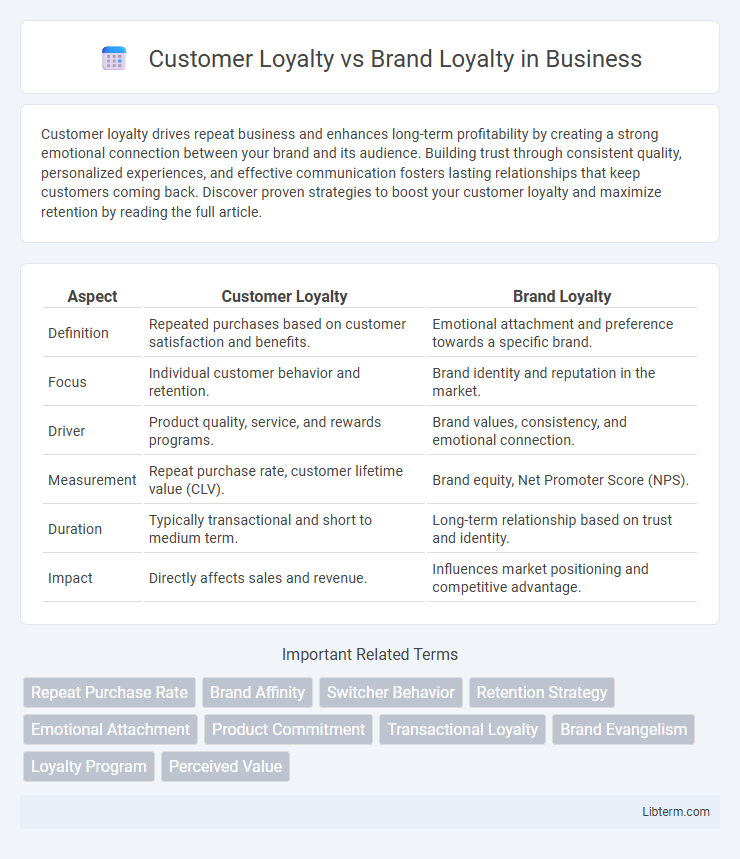Customer loyalty drives repeat business and enhances long-term profitability by creating a strong emotional connection between your brand and its audience. Building trust through consistent quality, personalized experiences, and effective communication fosters lasting relationships that keep customers coming back. Discover proven strategies to boost your customer loyalty and maximize retention by reading the full article.
Table of Comparison
| Aspect | Customer Loyalty | Brand Loyalty |
|---|---|---|
| Definition | Repeated purchases based on customer satisfaction and benefits. | Emotional attachment and preference towards a specific brand. |
| Focus | Individual customer behavior and retention. | Brand identity and reputation in the market. |
| Driver | Product quality, service, and rewards programs. | Brand values, consistency, and emotional connection. |
| Measurement | Repeat purchase rate, customer lifetime value (CLV). | Brand equity, Net Promoter Score (NPS). |
| Duration | Typically transactional and short to medium term. | Long-term relationship based on trust and identity. |
| Impact | Directly affects sales and revenue. | Influences market positioning and competitive advantage. |
Understanding Customer Loyalty: Definition and Key Traits
Customer loyalty refers to a consumer's consistent preference and repeat purchases of a company's products or services driven by satisfaction, trust, and perceived value. It is characterized by emotional attachment, positive experience, and willingness to recommend, fostering long-term engagement. Brand loyalty specifically emphasizes a strong, favorable attitude toward a brand, often influenced by brand identity, reputation, and emotional connection.
Defining Brand Loyalty: What Sets It Apart?
Brand loyalty is defined by a customer's consistent preference for a specific brand over competitors, driven by emotional connection, trust, and perceived quality. Unlike general customer loyalty, which may shift based on price or convenience, brand loyalty reflects a deeper commitment that results in repeat purchases and advocacy. Key indicators include high retention rates, brand engagement, and a willingness to pay premium prices, distinguishing brand loyalty as a critical asset in competitive markets.
Core Differences Between Customer Loyalty and Brand Loyalty
Customer loyalty centers on repeated purchases driven by satisfaction and value received, while brand loyalty involves a deeper emotional connection and preference for a brand irrespective of price or convenience. Customer loyalty can shift between competitors if better offers arise, whereas brand loyalty reflects long-term commitment and advocacy rooted in trust and identity. Understanding these distinctions helps businesses tailor strategies to either enhance transactional retention or build enduring brand relationships.
Psychological Drivers Behind Customer and Brand Loyalty
Customer loyalty stems from consistent satisfaction, trust, and perceived value, deeply influenced by emotional connections and the fulfillment of personal needs. Brand loyalty builds on these psychological drivers through identity reinforcement, brand personality alignment, and social proof, encouraging repeat purchases and advocacy. Both types of loyalty are sustained by cognitive biases such as the endowment effect, commitment, and the desire for consistency in consumer behavior.
The Role of Emotional Connection in Brand Loyalty
Emotional connection significantly enhances brand loyalty by creating a deep, personal attachment between consumers and the brand, leading to repeat purchases and advocacy. Unlike customer loyalty, which may be driven by transactional elements like discounts or convenience, brand loyalty stems from positive emotional experiences and trust. Brands that successfully evoke emotions through storytelling, values alignment, and exceptional customer interactions achieve higher retention and stronger competitive advantage.
Impact of Rewards and Incentives on Customer Loyalty
Rewards and incentives significantly enhance customer loyalty by encouraging repeat purchases and increasing engagement with a brand. Programs offering discounts, exclusive access, or points accumulation create emotional and transactional value, fostering stronger relationships. Data shows that 79% of consumers are more likely to continue doing business with brands that offer personalized rewards, directly impacting loyalty more than generic brand affinity efforts.
How Product Quality Influences Both Types of Loyalty
Product quality plays a pivotal role in shaping both customer loyalty and brand loyalty by directly impacting satisfaction and trust levels. High product quality encourages repeat purchases and positive word-of-mouth, fostering customer loyalty focused on consistent product performance. In contrast, brand loyalty is strengthened when superior product quality aligns with the brand's identity, reinforcing emotional connections and long-term commitment.
Strategies to Build Customer Loyalty vs Brand Loyalty
Building customer loyalty involves personalized communication, exceptional customer service, and loyalty programs that reward repeat purchases, fostering a direct emotional connection with the buyer. Brand loyalty strategies emphasize consistent brand messaging, quality product experience, and cultivating an aspirational brand identity to create long-term consumer trust and advocacy. Leveraging data analytics to tailor marketing efforts and ensuring brand values align with customer expectations are critical approaches to enhancing both customer and brand loyalty.
Measuring Success: Key Metrics for Loyalty Programs
Measuring success in customer loyalty and brand loyalty programs involves tracking key metrics such as repeat purchase rate, customer lifetime value (CLV), and Net Promoter Score (NPS). Repeat purchase rate indicates ongoing customer engagement, while CLV quantifies the total worth of a customer to the brand over time. NPS assesses customer satisfaction and likelihood to recommend the brand, providing insight into both loyalty types for targeted improvements.
Future Trends in Customer and Brand Loyalty
Emerging technologies like AI-driven personalization and blockchain transparency are shaping future trends in customer loyalty by enhancing trust and tailored experiences. Brand loyalty is evolving through immersive brand storytelling and community-driven engagement, fostering emotional connections that transcend transactional relationships. Data analytics will enable brands to predict loyalty shifts and customize retention strategies, blurring the lines between customer loyalty and brand loyalty in the digital era.
Customer Loyalty Infographic

 libterm.com
libterm.com